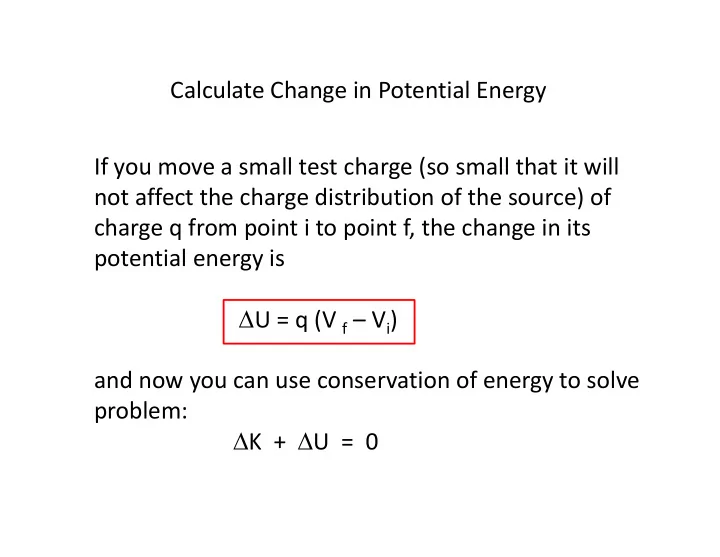

Calculate Change in Potential Energy If you move a small test charge (so small that it will not affect the charge distribution of the source) of charge q from point i to point f, the change in its potential energy is U = q (V f – V i ) and now you can use conservation of energy to solve problem: K + U = 0
Electric potential of a Constant Field y y=0 V - Ey - y 2 0 V=0 at the sheet of source charges (y=0)
Calculate the electric potential due to the source charges Electric potential due to a point charge: 1 Q r V V(r) E 1 4 r Q 0 Electric potential due to several point charges: V 1 +V 2 +V 3 r 1 1 Q i r 3 E Q 1 r 2 4 r i 0 i Q 2 Q 3 Electric field due to continuous charge distribution: r 1 dQ dE V dV dQ 4 r 0 Note that electric potential is a scalar, it is easier to calculate than electric field (vector).
General Observations 1. Electric field tends to point from a high potential point to a low potential point. 2. If you release a test charge particle from rest and let it go along the field line for a short time, the particle will go from a high potential point to a low potential point if it is positive in charge. In reverse, it will go from a low potential point to a high potential point if it is negative in charge.
Calculating Electric Field from Electric Potential Given an electric field, we can calculate the corresponding potential Z V at point A - E ( r ) d r A In reverse, given an electric potential, we can calculate the corresponding field: V V V ˆ ˆ ˆ E - V - i - j - k x y z
Class 14. Conductors and equipotentials
Equipotential A surface over which the potential is constant is called an equipotential. Since E = ‐ V, so E must be perpendicular to an equipotential surface.
All on Conductors (as a Source of Electric Field) The following are true for any shape of a conductor, including the ones with cavities inside it (but assume there is no charge inside the cavities). 1.If the conductor has a net charge, all charges will stay on the outer surface of the conductor. 2.There is no electric field inside the conductor. 3.The electric field outside the outer surface always perpendicular to the surface in the proximity of the conductor.
All on Conductors (as a Source of Electric Field) (Con’t) 4. Electric field is stronger at the sharper part (smaller radius of curvature) of the outer surface. 5. The conductor has the same potential, including the cavities (unless there are charges inside the cavities) and surfaces, through out the whole body.
Recommend
More recommend